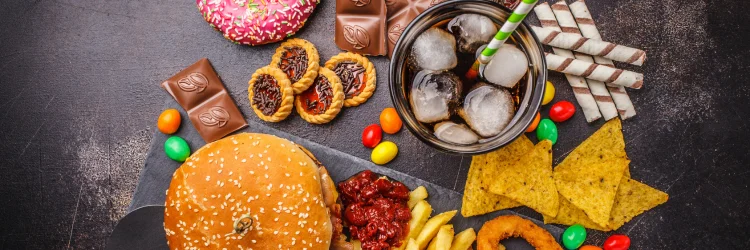- 39 New London Turnpike Suite 120 Glastonbury, CT 06033

BMJ [British Medical Journal]
October 9, 2023; Vol. 383; Article e075354
Ashley Gearhardt, Nassib Bueno, Alexandra DiFeliceantonio, Christina Roberto, Susana Jiménez-Murcia, Fernando Fernandez-Aranda. This study cites 99 references.
KEY POINTS FROM THIS ARTICLE:
1) Ultraprocessed foods (UPFs) are the major source of refined carbohydrates and added fats in diets.
2) “The Yale Food Addiction Scale assesses all 11 symptom criteria for substance use disorder in DSM-5, including diminished control over intake, cravings, withdrawal, and continued use despite negative consequence.”
3) “Two systematic reviews including 281 studies from 36 different countries found the overall pooled prevalence of food addiction using YFAS was 14% in adults and 12% in children.”
4) “Refined carbohydrates or [refined] fats evoke similar levels of extracellular dopamine in the brain striatum to those seen with addictive substances such as nicotine and alcohol.” [Important]
5) “Natural or minimally processed foods typically contain either carbohydrates or fat, they rarely contain both.”
6) Many UPFs contain much higher levels of both carbohydrates and fats in more equal proportions:
7) “The speed at which UPFs deliver carbohydrates and fats to the gut may also be important to their addictive potential.”
8) “Nuts have a high[er] ratio of fat to carbohydrate than most UPFs and the fats remain encapsulated in cell walls after chewing, making them unavailable, especially at the early stages of digestion.” This is important because:
9) “The ability of UPFs to rapidly deliver bioavailable rewarding substances may contribute to their increased addictive potential.”
10) Additive flavors contribute to the addictiveness of UPFs.
11) “In the U.S. there is a proposal to remove menthol flavoured cigarettes and flavoured cigars from the market because of their role in increasing addictive liability.”
12) Artificial sweeteners bind to receptors in the gut, “increasing the capacity to absorb glucose.” [This is an explanation as to why those who regularly consume artificial sweeteners actually gain weight: see Article Review 15-13: Fueling the Obesity Epidemic? Artificially Sweetened Beverage Use and Long-term Weight Gain].
13) “UPFs high in refined carbohydrates and fats are clearly consumed in addictive patterns and are leading to deleterious health outcomes.” [Key Point]
14) Refined carbohydrates and fats “seem to activate neural reward systems to a similar magnitude as nicotine and ethanol.” [Very Important]
15) “Processed tobacco leaves have been available for hundreds of years for people to make their own addictive tobacco products.”
16) “Food outlets in disadvantaged neighbourhoods are often dominated by UPFs, with limited access to minimally processed foods.”
17) “UPFs already have heightened appeal, and combined with their low cost, convenience, and marketing, it is hard for minimally processed foods to compete, particularly for those facing the stress of structural disadvantages.”
18) “The inclusion of a UPF addiction diagnosis in clinical care would be likely to improve access to support and enable the development of treatments to reduce compulsive patterns of UPF intake.”
19) “People find it challenging to reduce intake of addictive substances even when highly motivated, which challenges the personal responsibility narrative used by industry.”
20) The authors advocate for “regulatory safeguards to curtail industry practices such as the creation of UPFs that maximise ‘craveability’ by hitting consumers’ ‘bliss point,’ and the aggressive marketing of such products to children.”
COMMENTS FROM DAN MURPHY:
This article references the books by Michael Moss:
Salt, sugar, fat: How the Food Giants Hooked Us, 2013.
Hooked: Food, Free Will, and How the Food Giants Exploit Our Addictions, 2021.
I would also recommend The End of Craving, 2022.

39 New London Turnpike Suite 120
Glastonbury, CT 06033
